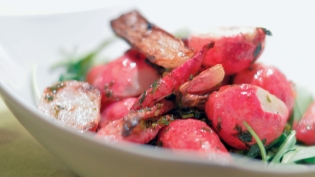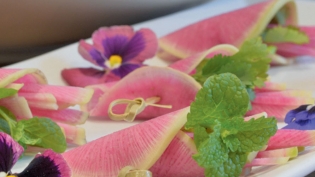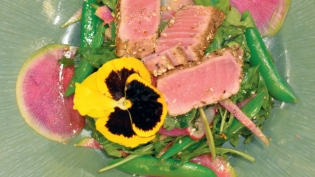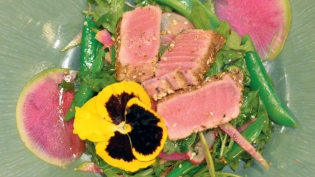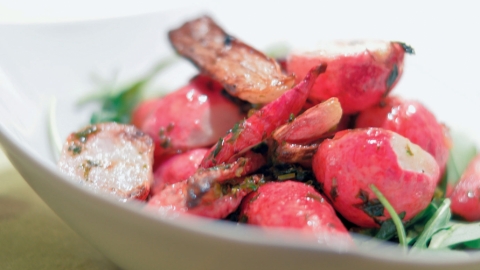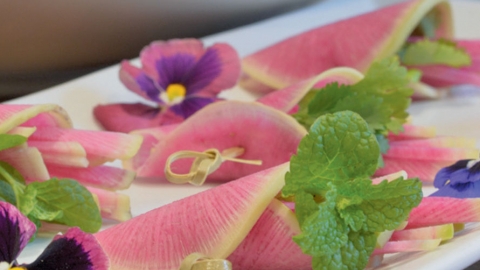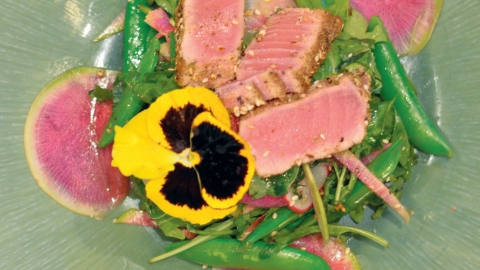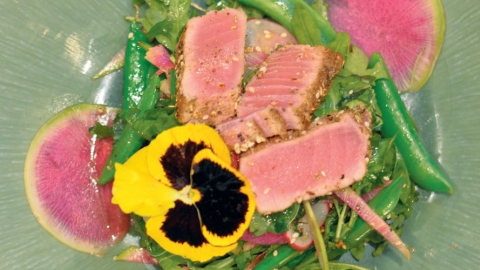Getting to Know Your Radishes
“Plant a radish. Get a radish. Never any doaubt. That’s why I love vegetables; you know what you’re about. They're dependable. They're befriendable.”
The dependability of the unassuming radish is celebrated in the above lyrics from the musical “The Fantasticks,” the longest running musical in history. Plant a radish seed and come spring, a plump radish is ready to greet you as one of the first signs of the spring harvest.
Now the befriendable part of the lyrics? That’s another matter. Radishes are not the most-loved vegetable in the spring produce basket. There’s a certain amount of anticipation that comes from spring vegetables, say asparagus and ramps. But radishes? They usually are not on the list of most-loved spring vegetables.
It’s time to open your heart to the radish. Get to know the multitude of radish varieties. Experiment with them in dishes. Or just eat them raw. Make this spring the season you befriend the radish.
AN EASY-TO-GROW, VERSATILE VEGETABLE
Radishes are high-reward plants. They grow extremely fast, with some of them maturing in as little as 22 days. They’re also incredibly easy to grow, taking off and producing with little to no human intervention, apart from some strategic thinning.
Select a nice sunny area to plant your radish patch. Direct sow seeds, ½-inch to 1-inch deep and 1-inch apart in rows 12-inches apart. For a continuous harvest, plant seeds in two-week periods. And don’t limit your radish planting to just spring: You can still plant radishes through late summer and enjoy a healthy harvest.
Remember to pick your crop when mature. The condition of the radishes will deteriorate quickly if left too long in the ground. Cut off the radish tops (or wash and save them to toss with roasted radishes), dry thoroughly and store in a bag in the refrigerator.
AN EDIBLE COLOR PALATE
When thinking about radishes, it’s the bright red variety that most often comes to mind. But radishes come in a multitude of sizes, shapes and colors. Some are round, some oval shaped, and some oblong and carrot-shaped. Colors range from the most common bright red hue to purple, pink, white, light green and even black.
Try experimenting with one or more of the many varieties of this unassuming vegetable. If you’re a home gardener, pick up some different varieties and add them to your spring plantings. If you’re more into hunting for produce at local farmers markets, you’re in luck. More and more vendors are offering a variety of radishes for sale.
Although the types of radishes seem never-ending, there are some that are most often available.
CHERRY BELLE – This round, red radish is the common variety most often found in your local supermarket. The cherry belle is delicious in salads as well as roasted.
EASTER EGG – This multi-colored variety can be white, pink, red or purple. Slice it thin to add flavor, texture and color to salads. When sold in a mixed bunch, they are often marketed as "Easter radishes" for their resemblance to dyed Easter eggs.
WATERMELON – This heirloom radish is distinguished by its white skin and intense, reddish-purple flesh. The watermelon radish is larger than most varieties, often growing to baseball size. Watermelon radishes are named for the reason obvious to anyone who has ever cut one to expose their brilliant red-pink interior. The flavor is mild with a mild, peppery finish.
Scrub them clean, cut them into wedges and serve them as a beautiful addition to a crudité display. The large size of the watermelon radish makes it the perfect choice for creating paper-thin slices using a mandoline slicer. These beauties are best served raw. Cooking dulls the bright watermelon-look of the radish.
LONG SCARLET – This long, carrot-shaped radish is a deep red/ purple color. It has a thin skin and a spicy flavor. Peel them and serve raw, like a whole carrot, with your favorite vegetable dip. Or slice in half and roast them like a carrot.
BLACK SPANISH – This round radish displays coal-black skin and pure white flesh. These pungent radishes grow larger than most, to about 5 inches in diameter. They also have a longer growing period. Maturity ranges from 35 days to 55 days or more. The flesh is stronger than some radishes but tends to have a slightly nutty flavor.
FRENCH BREAKFAST – This mild, extra-crunchy, slightly pungent radish is good raw or cooked. French radishes are slightly elongated versions of round radishes. The French breakfast radish has a reddish-pink color that tapers to white at the tip.
DAIKON LONG WHITE – The daikon is a huge radish that can reach lengths of 18 inches, measuring 3 inches in diameter. Often used in Asian cuisine, the daikon is terrific thinly sliced in a raw salad. It also holds up well as an addition to a slow-cooking stew or soup.
MAKE THE RADISH THE STAR OF THE DISH
Often thought of as just a salad garnish or carved into small rosettes to bring a pop of red color to a relish tray, the humble radish can provide so much more to the culinary plate. Make the radish the star of the dish by using it as a focal point in a salad, appetizer or side dish. Start with a simple feta radish appetizer. Pick a large radish, like a watermelon, and cut into thin slices. A mandoline slicer makes the slicing job easy. A mixture of feta, garlic and fresh herbs is spread on one side of the radish. Roll the radish so it is tight on one end. Garnish with a few fresh herbs or some matchstick-cut radishes. A simple sliced radish suddenly becomes an elegant edible cornucopia of flavor.
The radish plays well with other vegetables. Add some colorful sliced radishes to a salad of blanched spring snap peas and that first crop of tender greens. Toss with an oriental-style vinaigrette and finish with a seared piece of Ahi tuna. This dish just screams “hello spring.” (see Chef Terri prepare this dish in a video)
Many vegetables benefit from a quick visit in a high heat oven. An intense blast of heat brings out the natural sugar stored inside root vegetables. Slice or quarter your favorite mix of radishes, toss them lightly in olive oil and give them a sprinkling of sea or kosher salt. Place the radishes, cut side down, on a heavy baking sheet pan and, to maximize the caramelization, give them a final sprinkle of just a bit of sugar. Pop them into a 450-degree oven and wait. The resulting roasted radish will greet your palate with a mix of sweet and spicy in one flavorful warm bite.



